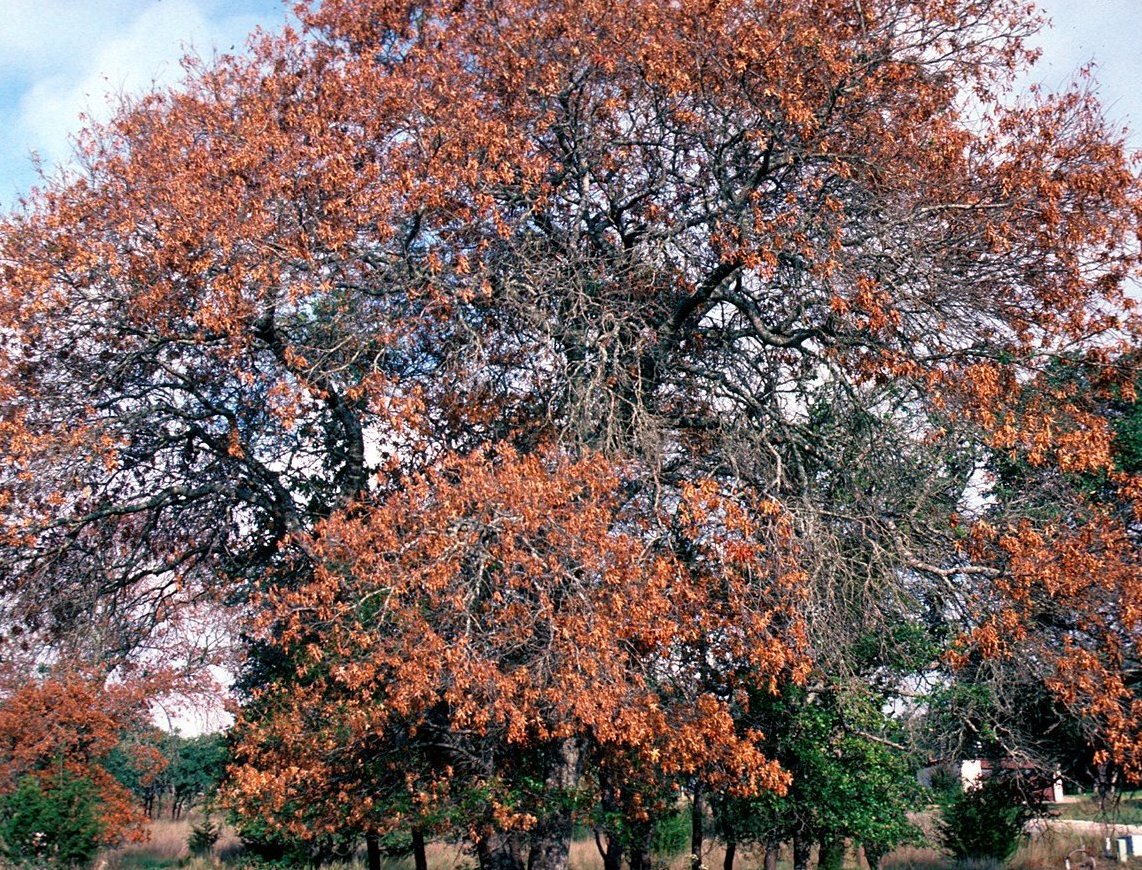What You Can Do to Stop Oak Wilt
By Paul Hetzler
It’s hard to be cheerful in a job where I am expected to keep up on each newly arrived or imminent threat from invasive insects, novel plant diseases, and worrisome trends in the environment. Although I typically deflate everyone’s happy-bubble when I give a talk, I’ve discovered we need not fret that the sky is going to fall.
Down in the States, the National Atmospheric Deposition Program is a joint effort of research institutions, government, and nonprofit groups. They monitor stuff which falls to Earth that is not some form of water. Since one of their tasks is to study tiny particles of pollutants in the air, they’ll certainly notice if the sky starts to fall, and give us ample time to take cover.
Kidding aside, when we hear bad news day in and day out, we can get the sense there is nothing we can do about any of it. That helpless feeling breeds anxiety and apathy. However, the up-side of knowing about threats to our forests and gardens is that often we’re able to make a difference. About 40% of the time, new invasive-species infestations are found by folks who knew about such issues, but who weren’t actively looking because it was not their job.
In 2017, a small infestation of hemlock woolly adelgid (HWA) was found by a hiker in northern NY State. This little creature (HWA, not the hiker) is lethal to hemlocks, and though it poses a real risk to the Adirondack Region, that person likely averted a major crisis. He knew about HWA, reported it, and as a result, the infestation was eradicated.
Therefore, I don’t feel so bad presenting yet another threat to our forests—oak wilt—because according to the CFIA, it’s not yet in any Canadian Province. In addition, there are several things we can do to help keep it that way. Discovered first in 1944 down in Wisconsin, it is now in 24 U.S. states, many of which on our southern border. The fungal pathogen that causes oak wilt is thought by many to have originated outside North America, but no one knows for sure.
What is known for sure is that oak wilt is a death-knell for red oaks. It kills healthy red, black, pin, and similar “red type” oaks in three to six weeks. It is similar to Dutch elm disease in that it plugs xylem tissue, blocking water uptake. Symptoms are rapid browning of leaves, usually in July or August, followed by leaf drop. Oak wilt spreads easily, and there is no known treatment. Lovely, I know.
“White type” species such as white, bur, and swamp white oaks can take from one to three years to die. This is not good news because they can infect nearby oaks without showing major symptoms.
Oak wilt is spread in two general ways; below ground and above ground. A tree’s roots extend two to three times its branch length, and as they cross paths with roots from related species, they often form graft unions. We know little about this “tree internet,” other than chemical signals can share news of, for example, the arrival of a pest from one edge of a wooded plot to the other. Sadly, root grafts also spread dreadful blights like Dutch elm disease, and now oak wilt. Such tree-to-tree spread, while important, is a lot slower than airborne transmission
Above ground, oak wilt is naturally spread by insects, especially sap beetles in the family Nitidulidae, which carry oak wilt spores from infected trees to fresh wounds on healthy oaks. The oak wilt fungus only produces spores on red-type oaks, on which sweet-scented spore pads develop. But all species of oak can be infected by a spore-covered nitidulid beetle. Rarely, birds may carry oak wilt spores, and it was recently found that powerful spring and early summer windstorms (the risk of infection drops significantly after midsummer) can vector the pathogen.
We are the other vector, of course. In 2018, new infestations cropped up in the Finger Lakes region of central NY, over 300 km from the nearest known oak wilt source. It is almost certain this was due to the transport of firewood.
We can help keep oak wilt away by changing a few habits. The easiest is to not bring firewood home with us when traveling. Trite as this may sound, it is vital. It’s dangerous to think oak wilt is hundreds of kilometers away. It is as close as the first idiot who brings firewood back from visiting his (and it’s always a guy who starts these calamities) buddy whose dead tree he helped cut up.
Between April 1 and July 1, the risk of spreading oak wilt is extreme if there is any exposed fresh-cut oak, whether a stump or a pruning wound. From July through September, the risk is moderate. Obviously, we might need to cut an oak branch or tree in this time. In that case, spray-paint the wound or stump immediately after cutting. I emphasize immediately because nitidulid beetles will find fresh oak sap within an hour. If possible, only prune or harvest oak from October through March.
Sorry for the echo, but if this pathogen spreads through Ontario, our oaks will be no more. By adopting these guidelines, we can greatly reduce the risk of having oaks vanish from our forests. If you suspect you have seen oak wilt, please report it to the CFIA at www.inspection.gc.ca/pests also www.eddmaps.org/ontario/
Never bring “free” firewood home from a trip. It’s a small thing to do to keep the sky from falling.
"Paul Hetzler is an ISA Certified Arborist, and the Natural Resources Educator for Cornell Extension of St. Lawrence County, NY. A recent Permanent Resident of Canada, he lives in Ottawa with his wife."


.JPG)
.JPG)

